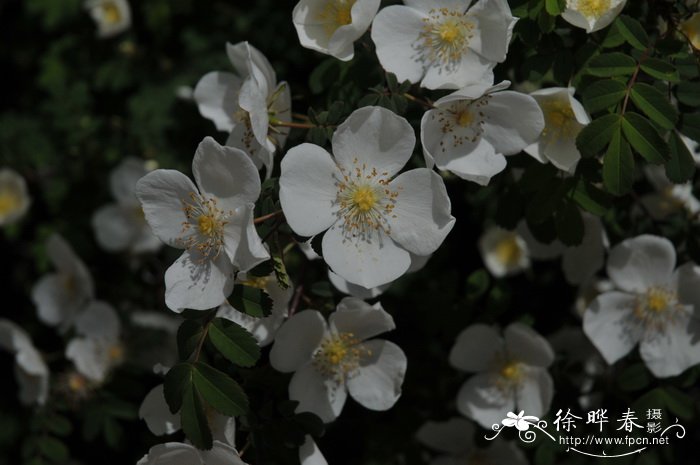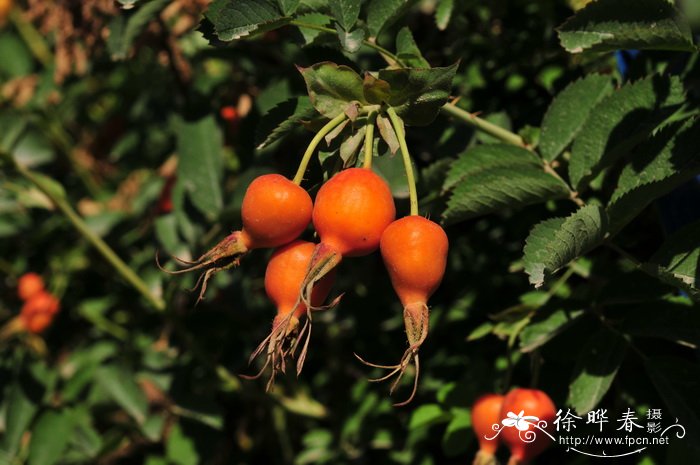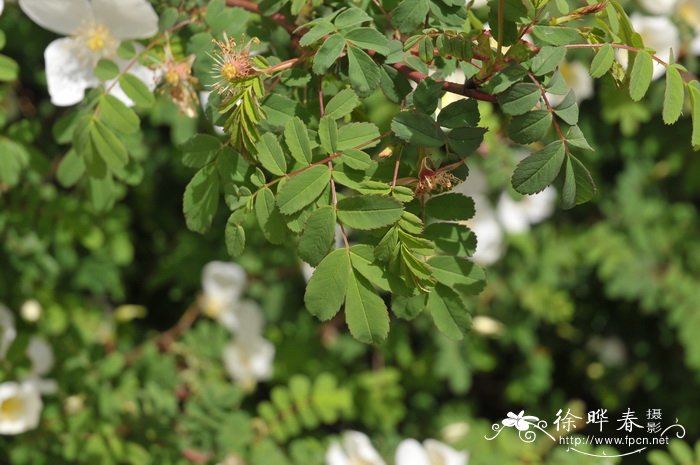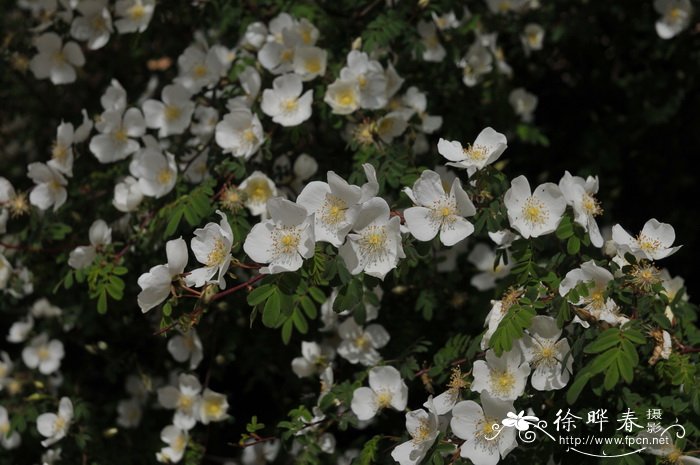峨眉蔷薇Rosa omeiensis
中文名(Chinese Name):峨眉蔷薇
学名(Scientific Name):Rosa omeiensis Rolfe
英文名(English Common Name):
别名(Chinese Common Name):刺石榴、山石榴
异名(Synonym):Rosa sorbus H. Lév. Rosa sericea f. inermieglandulosa Focke Rosa sericea f. aculeatoeglandulosa Focke Rosa sericea f. aculeata Focke ex H.L‚v., nom. nud. Rosa sericea f. aculeato-eglandulosa Focke Rosa sericea f. eglandulosa Focke ex H.L‚v., nom. nud. Rosa sericea f. inermis Focke ex H.L‚v., nom. nud. Rosa sericea f. inermiseglandulosa Focke
科属(Family & Genus):蔷薇科(Rosaceae)蔷薇属
形态特征(Description):直立灌木,高3-4米;小枝细弱,无刺或有扁而基部膨大皮刺,幼嫩时常密被针刺或 无针刺。小叶9-13(-17),连叶柄长3-6厘米;小叶片长圆形或椭圆状长圆形,长8-30毫米,宽4-10毫米,先端急尖或圆钝,基部圆钝或宽楔形,边缘有锐锯齿,上面无毛,中脉下陷,下面无毛或在中脉有疏柔毛,中脉突起;叶轴和叶柄有散生小皮刺;托叶大部贴生于叶柄,顶端离生部分呈三角状卵形,边缘有齿或全缘,有时有腺。花单生于叶腋,无苞片;花梗长6-20毫米,无毛;花直径2.5-3.5厘米;萼片4,披针形,全缘,先端渐尖或长尾尖,外面近无毛,内面有稀疏柔毛;花瓣4,白色,倒三角状卵形,先端微凹,基部宽楔形;花柱离生,被长柔毛,比雄蕊短很多。果倒卵球形或梨形,直径8-15毫米,亮红色,果成熟时果梗肥大,萼片直立宿存。花期5-6月,果期7-9月。
分布(Distribution):产云南、四川、湖北、陕西、宁夏、甘肃、青海、西藏,多生海拔750-4000米于山坡、山脚下或灌丛中。
用途(Use):根皮含鞣质16%,可提制栲胶。果实味甜可食也可酿酒,晒干磨粉掺入面粉可作食品,又可入药,有止血、止痢、涩精之效。
引自中国植物志英文版:FOC Vol. 9 Page 354
Rosa omeiensis Rolfe, Bot. Mag. 138: t. 8471. 1912.
峨眉蔷薇 e mei qiang wei| Rosaceae | Rosa
Rosa sericea Lindley f. aculeatoeglandulosa Focke; R. sericea f. inermieglandulosa Focke; R. sorbus H. Léveillé.
Shrubs erect, 1–4 m tall. Branchlets slender; prickles absent or if present, paired below leaves, terete, straight, to 7 mm, abruptly flaring to a broad base, or prickles winglike, to 1.5 cm and 3 cm in diam.; bristles absent or if present, dense. Leaves including petiole 3–6 cm; stipules mostly adnate to petiole, free parts triangular-ovate, margin serrate or entire, sometimes glandular; rachis and petiole with a few small prickles; leaflets (5–)9–13(–17), oblong or elliptic-oblong, 8–30 × 4–10 mm, abaxially glabrous or pubescent, glandular or not, adaxially glabrous, with concave midvein, base rounded-obtuse or broadly cuneate, margin acutely serrate, apex acute or rounded-obtuse. Flower solitary, axillary, 2.5–3.5 cm in diam.; pedicel 6–20 mm, glabrous; bracts absent. Hypanthium obovoid or pyriform, glabrous. Sepals 4, lanceolate, abaxially subglabrous, adaxially sparsely pubescent, margin entire, apex acuminate or long caudate. Petals 4, white, obtriangular-ovate, base broadly cuneate, apex emarginate. Styles free, shorter than stamens, villous. Hip bright to deep red or yellow, obovoid or pyriform, 8–15 mm in diam., glabrous or glandular-pubescent, with persistent, erect sepals; pedicel yellow, tapering to hip, 6–20 mm, stout, fleshy, glabrous. Fl. May–Jun, fr. Jul–Sep.
Abies forests, thickets, scrub, pastures, hillsides, slopes; 700--4000 m. Gansu, Guizhou, Hubei, Ningxia, Qinghai, Shaanxi, Sichuan, Xizang, Yunnan.
Four forms can be recognized: R. omeiensis f. omeiensis, which has leaflets abaxially pubescent to subglabrous and non-glandular; f. glandulosa T. T. Yü & T. C. Ku (Bull. Bot. Res., Harbin 1(4): 7. 1981), which has abaxially densely glandular leaflets; f. pteracantha Rehder & E. H. Wilson (in Sargent, Pl. Wilson. 2: 332. 1915), which has branches with purple, broad, flat, winglike prickles; and f. paucijuga T. T. Yü & T. C. Ku (Acta Phytotax. Sin. 18: 502. 1986), which has only 5–9 glabrous leaflets, slightly turgid fruiting pedicels, and is intermediate between R. omeiensis and R. sericea.
The root bark, which contains about 16% tannin, is used for tanning. The sweet, edible fruit are used medicinally and to ferment wine.




(责任编辑:徐晔春)
学名(Scientific Name):Rosa omeiensis Rolfe
英文名(English Common Name):
别名(Chinese Common Name):刺石榴、山石榴
异名(Synonym):Rosa sorbus H. Lév. Rosa sericea f. inermieglandulosa Focke Rosa sericea f. aculeatoeglandulosa Focke Rosa sericea f. aculeata Focke ex H.L‚v., nom. nud. Rosa sericea f. aculeato-eglandulosa Focke Rosa sericea f. eglandulosa Focke ex H.L‚v., nom. nud. Rosa sericea f. inermis Focke ex H.L‚v., nom. nud. Rosa sericea f. inermiseglandulosa Focke
科属(Family & Genus):蔷薇科(Rosaceae)蔷薇属
形态特征(Description):直立灌木,高3-4米;小枝细弱,无刺或有扁而基部膨大皮刺,幼嫩时常密被针刺或 无针刺。小叶9-13(-17),连叶柄长3-6厘米;小叶片长圆形或椭圆状长圆形,长8-30毫米,宽4-10毫米,先端急尖或圆钝,基部圆钝或宽楔形,边缘有锐锯齿,上面无毛,中脉下陷,下面无毛或在中脉有疏柔毛,中脉突起;叶轴和叶柄有散生小皮刺;托叶大部贴生于叶柄,顶端离生部分呈三角状卵形,边缘有齿或全缘,有时有腺。花单生于叶腋,无苞片;花梗长6-20毫米,无毛;花直径2.5-3.5厘米;萼片4,披针形,全缘,先端渐尖或长尾尖,外面近无毛,内面有稀疏柔毛;花瓣4,白色,倒三角状卵形,先端微凹,基部宽楔形;花柱离生,被长柔毛,比雄蕊短很多。果倒卵球形或梨形,直径8-15毫米,亮红色,果成熟时果梗肥大,萼片直立宿存。花期5-6月,果期7-9月。
分布(Distribution):产云南、四川、湖北、陕西、宁夏、甘肃、青海、西藏,多生海拔750-4000米于山坡、山脚下或灌丛中。
用途(Use):根皮含鞣质16%,可提制栲胶。果实味甜可食也可酿酒,晒干磨粉掺入面粉可作食品,又可入药,有止血、止痢、涩精之效。
引自中国植物志英文版:FOC Vol. 9 Page 354
Rosa omeiensis Rolfe, Bot. Mag. 138: t. 8471. 1912.
峨眉蔷薇 e mei qiang wei| Rosaceae | Rosa
Rosa sericea Lindley f. aculeatoeglandulosa Focke; R. sericea f. inermieglandulosa Focke; R. sorbus H. Léveillé.
Shrubs erect, 1–4 m tall. Branchlets slender; prickles absent or if present, paired below leaves, terete, straight, to 7 mm, abruptly flaring to a broad base, or prickles winglike, to 1.5 cm and 3 cm in diam.; bristles absent or if present, dense. Leaves including petiole 3–6 cm; stipules mostly adnate to petiole, free parts triangular-ovate, margin serrate or entire, sometimes glandular; rachis and petiole with a few small prickles; leaflets (5–)9–13(–17), oblong or elliptic-oblong, 8–30 × 4–10 mm, abaxially glabrous or pubescent, glandular or not, adaxially glabrous, with concave midvein, base rounded-obtuse or broadly cuneate, margin acutely serrate, apex acute or rounded-obtuse. Flower solitary, axillary, 2.5–3.5 cm in diam.; pedicel 6–20 mm, glabrous; bracts absent. Hypanthium obovoid or pyriform, glabrous. Sepals 4, lanceolate, abaxially subglabrous, adaxially sparsely pubescent, margin entire, apex acuminate or long caudate. Petals 4, white, obtriangular-ovate, base broadly cuneate, apex emarginate. Styles free, shorter than stamens, villous. Hip bright to deep red or yellow, obovoid or pyriform, 8–15 mm in diam., glabrous or glandular-pubescent, with persistent, erect sepals; pedicel yellow, tapering to hip, 6–20 mm, stout, fleshy, glabrous. Fl. May–Jun, fr. Jul–Sep.
Abies forests, thickets, scrub, pastures, hillsides, slopes; 700--4000 m. Gansu, Guizhou, Hubei, Ningxia, Qinghai, Shaanxi, Sichuan, Xizang, Yunnan.
Four forms can be recognized: R. omeiensis f. omeiensis, which has leaflets abaxially pubescent to subglabrous and non-glandular; f. glandulosa T. T. Yü & T. C. Ku (Bull. Bot. Res., Harbin 1(4): 7. 1981), which has abaxially densely glandular leaflets; f. pteracantha Rehder & E. H. Wilson (in Sargent, Pl. Wilson. 2: 332. 1915), which has branches with purple, broad, flat, winglike prickles; and f. paucijuga T. T. Yü & T. C. Ku (Acta Phytotax. Sin. 18: 502. 1986), which has only 5–9 glabrous leaflets, slightly turgid fruiting pedicels, and is intermediate between R. omeiensis and R. sericea.
The root bark, which contains about 16% tannin, is used for tanning. The sweet, edible fruit are used medicinally and to ferment wine.
(责任编辑:徐晔春)
踩一下[0]

顶一下[2]